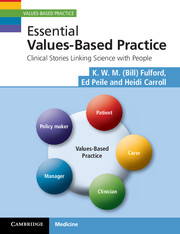Book contents
- Frontmatter
- Review quotes
- Contents
- Foreword
- Acknowledgements
- A bold claim to start this book
- Prologue: linking science with people
- Part 1 Values, individuals and an overview of values-based practice
- Part 2 The clinical skills for values-based practice
- Part 3 Relationships in values-based practice
- Part 4 Science and values-based practice
- Part 5 Bringing it all together
- Postcript: the small change of care
- A bold claim to end this book
- Appendix A Values-based practice summary and definitions of key terms
- Appendix B Values-based practice teaching framework
- Index
Appendix A - Values-based practice summary and definitions of key terms
Published online by Cambridge University Press: 05 June 2012
- Frontmatter
- Review quotes
- Contents
- Foreword
- Acknowledgements
- A bold claim to start this book
- Prologue: linking science with people
- Part 1 Values, individuals and an overview of values-based practice
- Part 2 The clinical skills for values-based practice
- Part 3 Relationships in values-based practice
- Part 4 Science and values-based practice
- Part 5 Bringing it all together
- Postcript: the small change of care
- A bold claim to end this book
- Appendix A Values-based practice summary and definitions of key terms
- Appendix B Values-based practice teaching framework
- Index
Summary
In this appendix, we summarize the essential features of values-based practice and give brief definitions of some of the key terms used in this book.
NOTE: Terms in bold correspond to terms highlighted in blue in the index, which in turn is supported by an index spreadsheet (on the VBP web site) showing what is covered by each of the highlighted index references.
Values-based practice
Values-based practice is a new approach to working with complex and conflicting values in healthcare that is:
Complementary to other approaches to working with values such as ethics (medicine's values tool box) in focusing on individual values
A partner to evidence-based practice in supporting clinical judgment in individual cases.
Values-based practice thus links science with the unique values of the particular people involved (clinicians, patients, carers and others) in a given clinical decision.
Values-based practice builds on a premise of mutual respect to support balanced decision-making through a ten-part process covering clinical skills, professional relationships, links with evidence-based practice and partnership.
Values
Values are anything positively or negatively weighted as a guide to action (for example, needs, wishes and preferences).
Values-based practice is a process that supports healthcare decision-making where complex and conflicting values are in play.
Complex values are values that mean different things to different people (for example, ‘best interests’)
Conflicting values are values that are in conflict one with another (for example, there are often tensions in healthcare decision-making between ‘best interests’ and ‘freedom of patient choice’).
- Type
- Chapter
- Information
- Essential Values-Based PracticeClinical Stories Linking Science with People, pp. 205 - 207Publisher: Cambridge University PressPrint publication year: 2012

